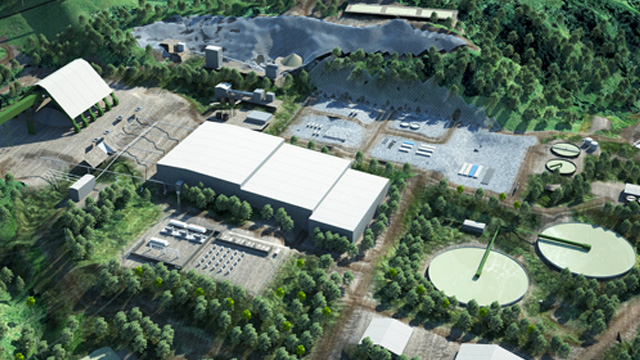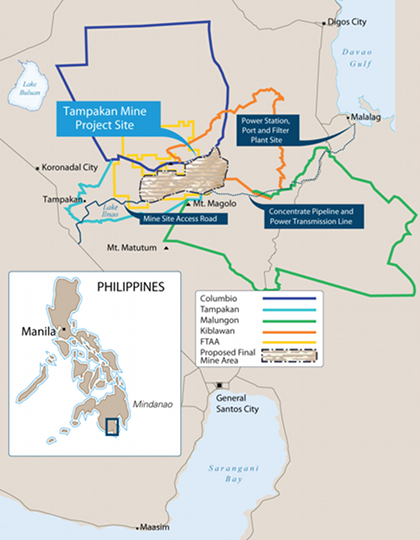SUMMARY
This is AI generated summarization, which may have errors. For context, always refer to the full article.

GENERAL SANTOS CITY, Philippines (UPDATED) — After announcing in December 2012 that it is moving its target for commercial operations to 2019, local mining firm Sagittarius Mines Incorporated (SMI) announced it is reducing its “activity and expenditure levels” that “will result in staff downsizing and a reduction in the utilization of contractors.”
In a press release on Monday, August 12, SMI executive vice president Justin Hiller said outstanding issues and challenges have not made possible for the company “to make adequate progress toward our Project goals.”
“Without fundamental change in approach, progress is unlikely to improve in the foreseeable future,” Hiller further stated.
Hiller added that they are revising their work plan and will concentrate on “resolving these issues.”
The issues include an open pit mining ban imposed by provincial government and the resettlement of the communities that would receive direct impact from the mining activities. The company is also yet to obtain permits from the government.
John Arnaldo of the Glencore Xstrata unit of SMI said that the company would cut off 85% of its workforce. Among the 1,060 strong employees and workers, 300 regular and project employees and about 620 contract workers would be laid off.
The revised work plan would trim the capital expenditure down to about $1 million a month, compared to the $4 million a month allotted by the previous 2013 work plan, he added.
Read: Major management shake-up looms in SMI
SMI is the operator of the Tampakan mine in South Cotabato in Mindanao, the country’s potentially biggest foreign investment. SMI had claimed that its US$5.9 billion Tampakan project will boost the Philippines’ gross domestic product (GDP) by 1%.
Open pit mining ban
For years, SMI has been faced with stiff opposition from the provincial government of South Cotabato. In 2010, local officials passed a local ordinance banning open pit mining, which is the mode for extracting mineral at the mine site.
“The outstanding issues and challenges facing the Tampakan Project include the resolution of the South Cotabato open-pit mining ban, the definition of the pathways to project approvals from all levels of government, and the gaining of consent and the resettlement of impacted communities,” the statement of Hiller added.
The mine site sits atop the mountainous village of Tablu in Tampakan, South Cotabato.

In February, SMI obtained the crucial environmental compliance certificate (ECC) from the government for its US$5.9 billion Tampakan Copper and Gold Project but it still has to seek the approval of the local government.
Read: Finally, Tampakan mine environmental clearance okayed
Read: Good and bad news in Tampakan mine’s ECC
South Cotabato Gov. Daisy Avance-Fuentes has repeatedly said she will implement the ordinance which she herself signed in June 2010, just days before stepping down to claim her seat in the House of Representatives.
In the May 2013 local elections, Fuentes regained her old post after defeating former Gov. Arthur Pingoy.
Fuentes has expressed concerns over water supply in Koronadal Valley once SMI is allowed to operate.
Mining policy
SMI has claimed that its mining operation will boost the economy of Region 12 (or the Soccsksargen region, which included South Cotabato) by 10%.
Based on SMI’s feasibility study, the mine is expected to pay the government $7.2 billion in total taxes and royalties per year under the current tax regime after a 5-year recovery period.
While the local government recognized the contribution of mining to the economy, it said the taxes the industry pays do not offset the environmental risks involved in their operations.
Read: Despite mining EO, Tampakan still in limbo
The Aquino government has championed efforts to improve its share of revenues from mining activities, which it says harm the environment.
In July 2012, the Aquino government issued an executive order banning the issuance of new mining permits. It said it will ask Congress to reform the current revenue-sharing provision of the mining law.
Church, rebels, indigenous peoples
The local Catholic Church headed by Bishop Dinualdo Gutierrez is also strongly opposed to the project saying its operations will only escalate resistance from indigenous people and increased activities from armed rebels in the area.
The communist-led New People’s Army has repeatedly threatened to launch attacks against the mining company. On New Year’s Day in 2008, a company of NPA rebels raided and torched the main base camp of SMI in the remote village of Table in Tampakan, South Cotabato.
In addition, several B’laan tribal leaders have taken up arms over what they called SMI encroachment of their ancestral lands.
“We look forward to working with the National Government through the Mining Industry Coordinating Council (MICC) to address these challenges,” SMI said in the statement. The MICC is the body tasked by the Aquino government to draft the proposed new provisions of the reform law.
SMI has reportedly already spent more than US$300 million, mostly underwritten by Xstrata, since it acquired the rights over the project in 2001.
The Tampakan has one of the largest copper and gold deposits in the world. It is expected to produce an average of 375,000 tons of copper and 360,000 ounces of gold over its 17-year life.
New global owners
The downsizing announcement came just 3 months after Glencore International completed the takeover of Xstrata Plc to form the world’s 4th largest diversified mining company and solidified Glencore’s status as the world’s largest commodities firm.
Before the takeover, Xstrata Plc was the world’s 4th largest copper producer.
Read: Xstrata-Glencore merger issues may delay Tampakan mine
Glencore-Xstrata owns the 62.5% controlling stake at SMI through its Australia-based subsidiary Xstrata Copper.
The remaining 37.5% share of SMI is owned by Indophil Resources NL, another Australia-based exploration company.
Local conglomerates also has minority stakes in Indophil: Gold producer Philex Mining Corp has a 1.3% stake, while San Miguel subsidiary Coastal View Exploration Corp. has about 3.99%. The Alsons group holds 20% of Indophil, while SM group also has minority stake.
Read: MVP, San Miguel in wait and see mode on Tampakan
A source who requested anonymity said only 5 of SMI’s core of managers will be retained as the company moves to reduce its operations.
SMI said it expects reactions from managers and employees who will be laid off.
“This decision has not been taken lightly; however, we expect it will take some time to resolve these complex matters effectively before the Project can again resume a path toward development,” SMI added.
The company assures it will continue to support host mining communities.
“We will continue to support our host communities through our committed development programs,” the company added.
The Tampakan mine is under a financial and technical assistance agreement (FTAA) with the national government. It is the only fiscal regime in the Philippines that permits 100% foreign ownership of a mine. – With reports from Agence France-Presse/Rappler.com
Add a comment
How does this make you feel?
There are no comments yet. Add your comment to start the conversation.